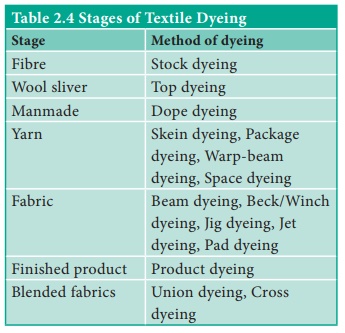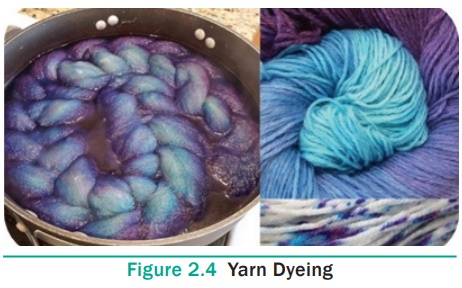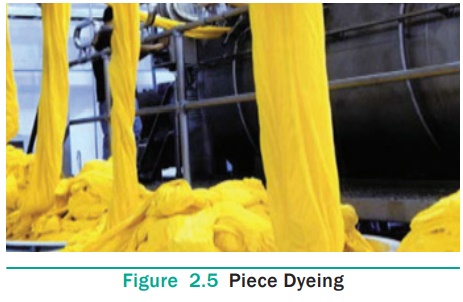Textiles and Dress Designing - Dyeing Methods | 12th Textiles and Dress Designing : Chapter 2 : Dyeing
Chapter: 12th Textiles and Dress Designing : Chapter 2 : Dyeing
Dyeing Methods
Dyeing Methods
The art of
dyeing dates back to
pre-historic times. It is practised from ancient time and it is as old
as human
civilization.
Dyeing is the process of imparting colour to the fibre/yarn or
fabric by the application of dyes or pigments. Colour is produced between the dye
molecule and the fibre or fabric. The bond between dye molecule and fibre may
be strong or weak depending on the dye used. Dyeing enhances the aesthetic look
of the fabric. It is one of the surface ornamentation methods.
1. Stages of Dyeing
Dyeing can be done at any stage of textile production process such
as at fibre stage, yarn stage, fabric or finished product.

1. Dyeing at Fibre Stage
The process of dyeing at fibre stage is called as fibre dyeing. It
includes stock dyeing, top dyeing and dope dyeing.
Stock Dyeing
Fibres are dyed by the process of stock dyeing. In this method,
dyeing is carried out in a large enclosed vessel called kiers. Fibres are
placed loosely in perforated containers and kept inside the kiers. The dye
liquor is circulated through the fibres at high temperature until the desired
colour is obtained. Excess dye solution is removed after dyeing process. The
dyed fibres are washed and dried.

Advantages
·
Produces varied colour effects by blending different coloured
fibres
·
Large quantities of fibres can be dyed at one time
·
Produces uniform colour
·
Colour fastness ranges from good to excellent
·
Dye easily penetrates the fibres and hence crocking is prevented.
Disadvantages
·
Expensive and time consuming
·
Fibre wastage if not consumed immediately
·
Dyed fibres loses its flexibility and hence not readily spin as
undyed fibre
·
Cannot withstand rapid changes in fashion
Top Dyeing
Wool that has been combed to remove short fibres is called as top.
Top is wound on perforated spools and dye solution is passed through it. Top
dyeing method results in even dyeing.

Advantages
·
Uniform dye uptake
·
Dye penetrates into the fibre therefore good colour fastness
Disadvantages
·
Flexibility is reduced
·
Time consuming
Dope dyeing
Manmade fibres such as polyester and polypropylene are dyed by
this method. In this method, dye is mixed with the spinning solution before the
filament is extruded through the spinneret.

Advantages
·
Dyeing is uniform
·
Dyed textiles have good to excellent colour fastness to washing
and light
Disadvantages
·
The strength of solution dyed filaments are slightly lesser
·
Expensive method
2. Dyeing at Yarn Stage
The process of dyeing at yarn stage is called as yarn dyeing. Yarn
dyeing is preferred to create interesting checks, stripes and plaids in the
fabrics. Yarn dyed fabrics are deeper and richer in colour. Fabric with dyed
warp and undyed weft are example for chambrays. This includes techniques like
skein dyeing, package dyeing, warp-beam dyeing and space dyeing.

Skein Dyeing
In this method, the yarns are loosely wound in hanks or skein
form. The hanks or skeins are hung on perforated rods and immersed in a dye
bath. The dye solution is circulated in and out of the yarn to achieve an even
shade. This method is commonly used for dyeing acrylic and wool yarns.
Advantages
·
Loose arrangement of yarn permits excellent dye penetration
·
Yarns retain softer feel
Disadvantage
·
Most expensive yarn dyeing method
Package Dyeing
Yarns are wound on cones, spools or similar units. These yarn
packages are arranged on perforated rods in a rack and immersed in a tank. The
dye solution is forced outside from the rods and forced back to the centre
under pressure through the packages so that, the dye penetrates the entire
yarn.
Advantages
·
Dyeing capacity is higher (550 kg) when compared to skein dyeing
(200 kg)
·
Material to liquor ratio is less
·
Uniform dyeing
Disadvantages
·
Package dyed yarns do not retain softness and loftiness feel
·
Not suitable for high twist yarns which will not allow dye to
penetrate
Warp-Beam Dyeing
This method is similar to package dyeing. In warp-beam dyeing, the
yarn is wound onto a perforated warp beam and placed in a tank containing dye
solution. Dyeing is carried out under pressure for deeper and uniform
penetration of dye. This method is used for the manufacturing of denims, in
which warp yarns are dyed with indigo and weft yarns are left undyed.
Advantage
Economical than other yarn dyeing methods
Disadvantage
May not produce high fashion fabric since warp yarn will be dyed
in specific colour
Space Dyeing
In this method yarn is not completely dyed, but it is dyed at
intervals. Space dyeing is done by two methods namely, Knit-de-knit method and
OPI space -dye applicator method. In knit-de-knit method, the knitted fabric is
dyed and de-knitted, which results in appearance of alternating dyed and
un-dyed spaces. In OPI space-dye applicator method, the yarns are allowed to
pass through space dye baths at very high speed which results in intermittent
dyeing.
Advantages
·
Produces brighter and deeper shades.
·
Create interesting checks, stripes and plaids.
Disadvantages
·
Costly and time consuming
·
May not create designs to match current fashion
3. Dyeing at Fabric Stage
The process of dyeing woven or knitted fabric is called as piece
dyeing. Piece dyeing methods include beam dyeing, beck or winch dyeing, jig
dyeing, jet dyeing and pad dyeing.

Advantages
·
Uniform dyeing
·
Inexpensive than fibre or yarn dyeing
·
Versatile and flexible in accommodating changing fashion trends.
·
Faster and easier
Disadvantage
·
The ends of the fabric does not have some colour as the remaining
fabric
Beam Dyeing
This process is similar to warp -beam dyeing of yarns. In this
method, the woven or knitted fabrics are wound on perforated beams and immersed
in dye solution. Dye is circulated through the fabric
Beck / Winch Dyeing
This method is done to dye the fabrics of longer length. The
fabric is circulated through the dye bath in tensionless rope form. The ends of
the fabric are tied together to form a loop. The fabric moves over a rail onto
a winch reel which immerses it into the dye bath and draws the fabric up. The
process is repeated till the fabric is dyed uniformly and to the desired colour
shade. About 1000 m or 900 kgs of fabric can be dyed at a time. The dyed
fabrics retain its original softness feel. This method is widely used for
woolen woven and knitted fabrics.
Jig Dyeing
In this method, the fabric is held on rollers at full width and
passed through the dye bath. The fabric is let off from one roller into the dye
bath and wound on to the other roller. After one cycle, the process is reversed
and the fabric is let off from the second roller to the first. The process is
repeated till the desired colour strength is achieved. About 250 kg of fabric
can be dyed at a time. This method is preferred for heat-sensitive
thermoplastic fabrics that cannot be dyed in rope form as they will form
permanent crease or colour streaks in the fabric. This method is not suitable
for knitted or stretch fabrics which should not be subjected to tension and
also to fabrics where a soft feel is required.
Jet Dyeing
In this method the fabric is dyed in a rope form. It is placed in
a heated tube or column where jets of dye solution are thrown on the fabric at
high pressure. The fabric also moves along the tube. The dye solution is
circulated faster than the fabric while colouring it thoroughly. About 500 kg
of fabrics can be jet-dyed at a time. This method of dyeing is suitable for
both woven and knitted fabrics made up of wool, cotton, viscose rayon,
polyester and its blends.
Pad Dyeing
In pad dyeing, the fabric at full width is passed through a trough
containing dye bath. The fabric is then passed between two heavy rollers which
force the dye to penetrate in to the fabric and squeeze out the excess dye
solution. For the dye to set, the fabric is passed through a heat chamber. Then
the dyed fabric is rinsed and dried.
4. Dyeing at Product Stage
This is the last stage of dyeing. When the finished product such
as garment is dyed, it is called as product dyeing or garment dyeing. The
fabric undergoes pre-treatments such as desizing, bleaching and mercerization
before dyeing. The most widely used method for garment dyeing is paddle dyeing.
In this method, garments are packed loosely in net bags. Ten to fifty of such
bags are kept in large tubs containing dye solution. The dye is agitated by a
motor driven paddle which increases the penetration of dye. Garment dyeing is
suitable for products such as sweaters, T-shirts, casual clothing and hosiery.
Advantages
·
Economical
·
No shade variations
Disadvantages
·
Colour bleeding and fading.
·
Not suitable for products with zippers, sewing, threads, lining
etc.
2. Dyeing of Blended Fabrics
When a fabric is made of one type of fibre/ yarn, dyeing process
is simple but when it is composed of more than one kind of yarn as in a blend,
dyeing process is complex. Special procedures are carried out where different
dyes that are suitable for each fibre need to be selected.
1. Union Dyeing
In this method, blended fabrics are dyed to the same shade to get
a solid-coloured fabric. Fabrics can be dyed by one or two bath process. In one
bath process, dyes appropriate for each fibre is added in same dye bath. In two
bath process, dyes are added separately to each fibre subsequent to one
another.
2. Cross Dyeing
In this method, fabrics are dyed in such a way that different
fibres produce different shades with the same colour. Sometimes, one of the
fibre components is left undyed. Cross dyeing results in checks, plaids,
striped and multi-coloured fabrics. Cross dyed fabrics are similar to fibre or
yarn dyed textile materials. If one of the yarns of the fabric is vegetable
fibre and the other is from animal fibre, then the fabric is dyed in two
separate baths, suitable for each fibre. This produces colourful effects.
Related Topics